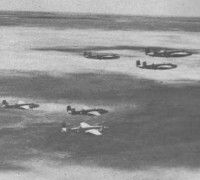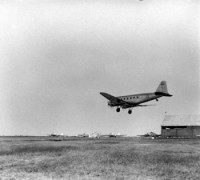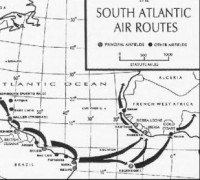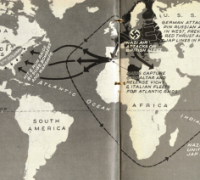The major part of the route to the Middle East passed over either Brazilian territory or that controlled by Great Britain. Brazil was completely cooperative in permitting American aircraft of all types, whether manned by military or civilian crews, to fly over her territory or land at bases on her soil.
Here was a case of the Good Neighbor policy paying practical dividends. Britain, the chief recipient of lend-lease aid in the form of supplies sent by air to Africa, was able to contribute a number of sites for bases all along the southeastern route. In the Caribbean the United States secured, through the destroyer-base lease agreement, sites for air bases on the islands of Trinidad, Jamaica, St. Lucia, and Antigua, and in British Guiana on the South American continent.
The Trinidad and British Guiana bases became major stopping points for transient aircraft, bridging the 2,000 miles that separated Puerto Rico from Belem, Brazil, the northernmost base in that country capable of handling heavy traffic. The base on Ascension Island was located on British territory, as were most of the bases along the west coast of Africa and across central Africa to Cairo.
Ferrying operations over the South Atlantic route had begun in June 1941 when Atlantic Airways, Ltd., a Pan American Airways subsidiary corporation organized especially for the job, undertook to deliver twenty transport-type aircraft to the British in western Africa.
Shortly after the passage of the Lend-Lease Act, the British government had requested, under terms of the act, a minimum of fifty transport planes for its trans-Africa operation. These planes were to be placed on the run between Takoradi in the Gold Coast Colony and Cairo--an airway of the highest strategic value in the line of communications between the British Isles and the Middle East.
The trans-Africa route had been pioneered by the British in the immediate prewar years, and at the outbreak of the war Imperial Airways maintained a regular transport service over the run between Khartoum in the Anglo-Egyptian Sudan and Lagos on the Nigerian coast.
Coastal bases had been constructed at Bathurst (Gambia), Freetown (Sierra Leone), and at Takoradi and Accra in the Gold Coast Colony. Across the waist of Africa, airfields had been cut from the jungle or laid out on the desert at Kano and Maiduguri in Nigeria, at Fort Lamy in French Equatorial Africa, and at El Geneina, El Fasher, and El Obeid in the Anglo-Egyptian Sudan.
With the loss of the French fleet in 1940 and the growing activity in the spring of 1941 of German air forces based on Sicily, the British line of air and water communications with Egypt by way of the Mediterranean was virtually closed. Fortunately, the existence of the trans-African air route enabled the British to avoid shipping aircraft by water all the way around Africa and up through the Red Sea to Egypt.
A large base and an assembly plant were developed at Takoradi, and here fighter and bomber aircraft, waterborne from Britain, were assembled, tested, and then ferried across Africa to Cairo. Beginning in the fall of 1940, British ferry pilots began moving Hurricanes and Blenheims along this route. The ferrying operation demanded also a transport service for returning pilots to Takoradi following the completion of deliveries to Cairo, and for hauling critical items of supply east from Takoradi.
Realizing the importance of maintaining and increasing the scope of the trans-African operation, the United States government, acting through the Civil Aeronautics Administration, undertook to secure the transport aircraft from the civil airlines. Of the fifty requested, however, only twenty could be spared by the airlines, and no Army planes were available.
And when the job of getting the planes to Africa was given the Air Corps, General Arnold found that neither military nor civilian crews with the necessary experience were immediately available. The few experienced Army crews could not be spared; and the country had long since been combed for civilian pilots and navigators for the North Atlantic ferrying service.
Rather than ship the planes by water, the ferrying job was turned over to Pan American Airways, whose experience in the development of commercial airlines through Latin American already had been turned to advantage in the effort to extend and strengthen hemisphere defenses.
As early as November 1940, Pan American had been made the agent of the United States government in carrying out the so-called Airport Development Program (ADP) for the construction and improvement of airports on foreign territory throughout the Caribbean area, Central America, and Brazil, as well as in Liberia.
Transcribed by Patrick Clancey - Hyper War Foundation.



